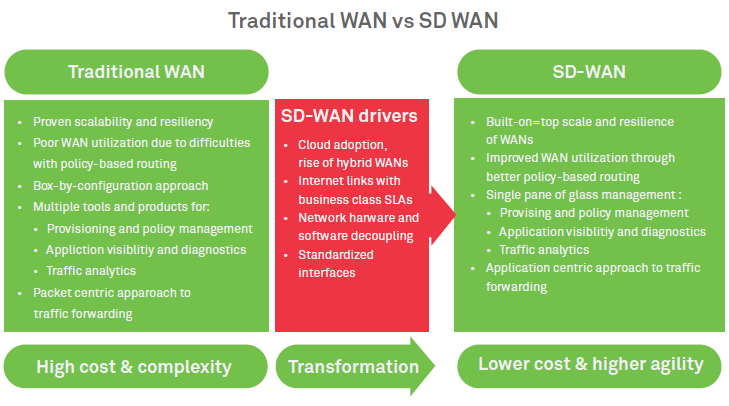Traditional MPLS (Multiprotocol Label Switching), used to manage branch connectivity and network traffic, isn’t cutting it any more. In its place, SD-WAN (Software Define Wide Area Networks) is mainstreaming. Major enterprises are busy examining SD-WAN as a means of dealing with growing network traffic, triggered by the migration of networks and datacenters to Cloud; the proliferation of Internet of Things (IoT); the focus on collaboration; and by the bottomless demand for wireless end-user devices and rich, bandwidth-intensive applications.
What is changing with SD-WAN?
SD-WAN creates an overlay on the existing network topology. This layer provides enterprises with central control over branch connectivity. They can use this layer to prioritize traffic based on business rules achieving this with greater security using encryption, next generation firewalls, web filtering, and threat management based on location, session, user and application. In addition, a variety of components can be added to SD-WAN implementation such as controllers for device management and, sometimes, an analytics engine for optimizing cloud workloads and monitoring.
One study in North America found that by 2017, 74% of respondents had already tried the technology in labsi . Not surprisingly, one leading analyst predicts that worldwide SD-WAN infrastructure and services revenues will see a compound annual growth rate (CAGR) of 69.6% and reach $8.05 billion in 2021ii. Clearly, branch connectivity using traditional WANs - that have not been architected for cloud and have always had security concerns - are primed for retirement.
There are compelling reasons for SD-WAN adoption: The technology reduces latency, it optimizes use of WAN infrastructure, brings down costs and gives better management control (for more details see traditional WAN versus SD-WAN). Today, with 55% of IT budgets taken up by WANs, CTOs are being naturally drawn to SD-WAN.

Figure 1: Traditional WAN vs SD WAN
With SD-WAN trending, every CTO must ask, “In which line of my business can SD-WAN bring value and the highest ROI? And what is the business case for SD-WAN?”
Defining the business case
Identifying and defining the business case is the first step in SD-WAN adoption. Typically, businesses will want to increase the available bandwidth as they expand. Doing this with MPLS is expensive. SD-WANs make it easy to increase bandwidth without adding to costs. Often, businesses are in the process of retiring old technology. At this point, they would want to consider SD-WAN and upgrade their infrastructure to take advantage of MPLS, broadband and 4G. Finally, SD-WANs provide visibility into applications allowing administrators to prioritize traffic based on application criticality. This has the net effect of improving user experience and ensuring that business is not affected due to poor bandwidth. The other drivers for SD-WAN adoption include agility and security. Automation can speed up configuration and deployments while traffic from data-sensitive applications can be isolated for enhanced security.
Analyzing the business case
Once the business case is defined and business goals set, effort should be directed to analyzing the business case for appropriate solutions. This involves examining:
• Network architecture: This includes understanding the type of routers, links and potential software upgrade required
• Utilization: Link utilization and the impact of outbound traffic on inbound and vice versa, along with the type of links (symmetric or asymmetric) which business are constantly trying to optimize
• Application landscape: Type of applications, their behavior and SLAs associated with the applications. Special attention needs to be paid to the following category of applications:
• Security analysis: This is an important aspect of the analysis, and the solutions implemented must align with compliance requirements of the business. The analysis must include:
• Cost: Capturing the complete maintenance and management cost of the WAN implementation. This will include:
Identifying potential problems
During the analysis stage the technical shortcomings of the WAN need to be understood and documented. This will form a major input in determining the specifications of the SD-WAN. This stage requires data from existing network monitoring platforms or from the service provider, and then subjecting the data to analysis. Some of the key areas to be analyzed include:
Choosing an SD-WAN
By creating a business case, analyzing it and listing problem areas, the most suitable SD-WAN solutions can be identified. At this stage, the business needs the assistance of an experienced system integrator who can evaluate the multiple SD-WAN choices and determine the best fit solution.
The SD-WAN market is crowded with vendors. It is difficult for a business to determine the technical features that will meet business requirements, overcome existing problems and deliver a future-proof solution. This should be left to the SI partner.
The benefits of SD-WANs are irrefutable. These benefits are technical and commercial in nature. They solve several problems associated with traditional WANs. Going forward, with the increasing adoption of Cloud-based technologies, growing business locations, the need for unified communications and the growth in video-based collaboration a business will be left with no alternative but to capitalize on SD-WAN.
References
Ramesh N G - Director Network Services, Cloud & Infrastructure Services, Wipro Ltd.
Ramesh has 18 years of experience in the field of information technology, networking infrastructure architecting, and technical delivery. He specializes in the field of software defined, traditional and Cloud networking areas. Currently, he heads the software defined networking practice globally within Wipro’s Cloud & Infrastructure Services. He leads a team of SDN solution architects, Cloud and Openstack networking professionals, to shape the future of the SDN business for Wipro in global geographies. He holds multiple industry leading certifications which include juniper networking professional certification as well as and Openstack certifications from Red Hat and Mirantis.